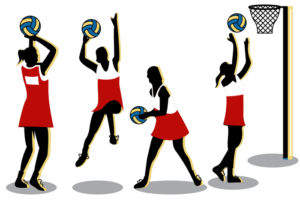Netball Injuries
 Netball is a game of fast movements, including jumping, throwing and rapid changes of direction. Injuries involving the knee and foot are a common consequence.
Netball is a game of fast movements, including jumping, throwing and rapid changes of direction. Injuries involving the knee and foot are a common consequence.
While fitness helps, good jumping and landing techniques, a thorough warm-up before the game, and cool-down after the game will help prevent injury.
Should you become injured, it is important to see a qualified physiotherapist for a rehabilitation program tailored specifically for you. The physiotherapists at Hoppers Physiotherapy are well trained to do this. They can
- Diagnose the injury and pinpoint the cause
- Prescribe a suitable treatment
- Start you on your rehabilitation to get you back to netball ASAP
- Follow up to ensure all is progressing well
- Teach you the tricks to prevent further injuries
COMMON NETBALL INJURIES
Ankle sprains
A poor landing can easily result in going over on your ankle. Pain, swelling and some bruising may be evident, as well as difficulty putting weight on the sprained ankle. RICE (rest, ice, compression, elevation) should be followed by a physiotherapist-prepared programme of stretching and strengthening exercises to reduce ankle pain and stiffness and promote flexibility and movement. Calf muscles tend to become tight to protect the sprained ankle, so it is especially important to stretch them. Your physio can also strap your ankle and provide balancing exercises to prevent the ankle from being re-injured.
Patellar tendinopathy or “Jumper’s Knee”
The constant jumping and landing in netball can lead to patellar tendon pain and tenderness in the knee which continues at rest, and is aggravated by trying to straighten the knee. Squatting and kneeling may also be difficult. Treatment consists of the RICE protocol and physiotherapy treatment.
Shin pain
Repetitive stress on the shins will cause pain and tenderness. At first, shin pain may be felt only during play but later can continue throughout the day. It may become chronic, side-lining the athlete for a long time. Rest is vital and strapping may help symptoms. A thorough assessment of foot posture and netball techniques by your physiotherapist is crucial to determine the cause of shin pain and the type of treatment needed before you can return to netball.
Achilles tendinopathy
This common and painful condition is characterised by pain at the back of the heel which increases with exercise, decreasing when exercise ceases. The sufferer also has difficulty walking or rising up on the toes. Continued pressure on the Achilles tendon may cause it to snap, sometimes with a loud popping sound. Early application of RICE is essential, followed by treatment by your physiotherapist and a program of exercises to stretch and strengthen the calf muscles to prevent re-injury.
These are just some of the more common injuries suffered by netball players. Remember, all rehabilitation programs require persistence and dedication to enable optimal recovery. Your well-trained physiotherapist at Hoppers Physio will guide you through every stage, and get you back on court as soon as possible.
So remember, if you are injured, help is at hand. Call the friendly staff at Hoppers Physio and make an appointment now.
